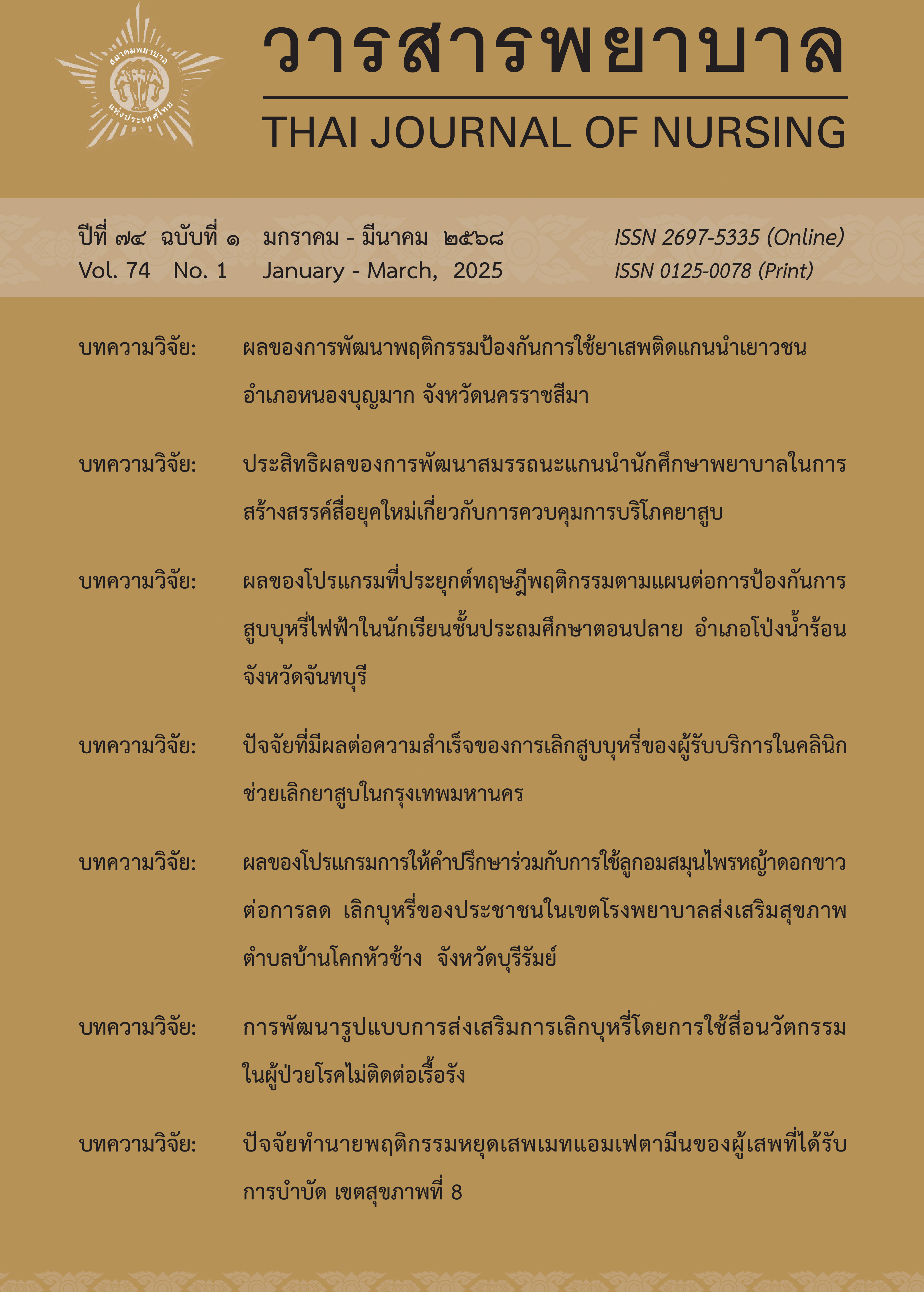The development of smoking cessation promotion model by using innovation media among patients with noncommunicable diseases
Main Article Content
Abstract
The objectives of this research were to explore smoking behavior and smoking cessation pattern, to develop and to examine the effect of the smoking cessation promotion model by using innovative media. The study sample consisted of 5 health personnel involved in smoking cessation, 10 patients in situation analysis phase and 27 patients in the study of model phase. Data collection was performed by using semi-structured interviews and questionnaires. Descriptive statistics, content analysis, and paired t-test were employed for data analyses. Results revealed that there were some patients with non-communicable diseases remained their smoking behavior and smoking cessation was provided by discussion on health hazards of tobacco. The developed smoking cessation promotion model included smoking history taking and patients assessment, assessing readiness to quit, nicotine dependence, effects of cigarette on health using innovative media, setting the quit date, and follow-up. After using the model, it was found that the patients had better average scores of knowledges, perceived severity, perceived risk, perceived benefits, perceived barriers, and nicotine dependence than before using the model with statistical significance of p < .001. The satisfaction towards the use of the model among the health personnel and patients were at the highest level.
Article Details

This work is licensed under a Creative Commons Attribution-NonCommercial-NoDerivatives 4.0 International License.
References
กระทรวงสาธารณสุข กรมควบคุมโรค. (2565). แผนปฏิบัติการด้านการควบคุมยาสูบแห่งชาติ ฉบับที่สาม พ.ศ. 2565 -2570. อักษรกราฟฟิคแอนด์ดีไซน์.
ชนิดา รำขวัญ, กุสุมา คุววัฒนสัมฤทธิ์, และอรสา พันธ์ภักดี. (2559). ปัจจัยที่มีความสัมพันธ์กับพฤติกรรมการเลิกสูบบุหรี่ในผู้ป่วยหลังผ่าตัดทำทางเบี่ยงหลอดเลือดหัวใจ. วารสารพยาบาลโรคหัวใจและทรวงอก, 27(2), 1-15.
ทิตาวดี สิงห์โค, ศากุล ช่างไม้, และทิพา ต่อสกุลแก้ว. (2563). ผลของโปรแกรมส่งเสริมการรับรู้ความเชื่อด้านสุขภาพต่อพฤติกรรมการป้องกันโรค หลอดเลือดสมองและการรับรู้ประโยชน์ของการคงไว้ซึ่งพฤติกรรมในผู้สูงอายุกลุ่มเสี่ยง. วารสารโรงพยาบาลเจริญกรุงประชารักษ์, 16(2), 42-60.
ทิพวัลย์ ธีรสิริโรจน์. (2565). การสร้างความตระหนักและส่งเสริมการปรับเปลี่ยนพฤติกรรม เพื่อลด ละ เลิกบุหรี่ในผู้ป่วยโรคไม่ติดต่อเรื้อรัง. วารสารพยาบาลศาสตร์ มหาวิทยาลัยคริสเตียน, 9(1), 97-113.
ธนะวัฒน์ รวมสุก, สุรินธร กลัมพากร, และทัศนีย์ รวิวรกุล. (2561). ผลของโปรแกรมเลิกบุหรี่โดยประยุกต์ใช้ทฤษฎีแรงจูงใจเพื่อป้องกันโรคในผู้ป่วยโรคความดันโลหิตสูง. วารสารพยาบาล, 68(1), 1-10.
ธนะวัฒน์ รวมสุก, อารยา ทิพย์วงศ์, พรพรรณ วรสีหะ, นงนุช วงศ์สว่าง, และณิชมน หลำรอด. (2564). ความรอบรู้ทางสุขภาพด้านความรู้ ความเข้าใจเกี่ยวกับบุหรี่ และพฤติกรรมการสูบบุหรี่ของผู้สูงอายุ: กรณีศึกษา อำเภออัมพวา จังหวัดสมุทรสงคราม. วารสารวิจัยวิทยาศาสตร์ทางสุขภาพ, 15(1), 131-140.
ภาวินี แสงจันทร์ และชวนชม ธนานิธิศักดิ์. (2561). การพัฒนาแอปพลิเคชันสำหรับให้บริการเลิกบุหรี่โดยเภสัชกรชุมชน. ศรีนครินทร์เวชสาร, 33(2), 169 -175.
มัลลิกา มาตระกูล และนาตญา พแดนนอก. (2564). การพัฒนารูปแบบการช่วยเลิกบุหรี่โดยการสัมภาษณ์เพื่อเสริมสร้างแรงจูงใจสำหรับนักศึกษาระดับอุดมศึกษา. วารสารพยาบาลทหารบก, 22(2), 231 - 240.
วิชัย เอกพลากร, หทัยชนก พรรคเจริญ, และวราภรณ์ เสถียรนพเก้า. (2564). การสำรวจสุขภาพประชาชนไทยโดยการตรวจร่างกาย ครั้งที่ 6 พ.ศ. 2562 - 2563. อักษรกราฟฟิคแอนด์ดีไซน์.
ศูนย์วิจัยและจัดการความรู้เพื่อการควบคุมยาสูบ. (2563). รายงานสถานการณ์การบริโภคยาสูบของประเทศไทย พ.ศ. 2563. สินทวีกิจ พริ้นติ้ง.
สุปาณี เสนาดิสัย และสุรินธร กลัมพากร. (บก.). (2563). บุหรี่กับสุขภาพ: พยาบาลกับการควบคุมการบริโภคยาสูบ (พิมพ์ครั้งที่ 3). เครือข่ายพยาบาลเพื่อการควบคุมยาสูบแห่งประเทศไทย.
Burns, N., & Grove, S. K. (2016). The practice of nursing research (8th ed.). Saunders.
Heatherton, T. F., Kozlowski, L. T., Frecker, R. C., & Fagerström, K. O. (1991). The Fagerström Test for Nicotine Dependence: A revision of the Fagerström Tolerance Questionnaire. British Journal of Addiction, 86(9), 1119-1127. https://doi.org/10.1111/j.1360-0443.1991.tb01879.x
Rosenstock, I. M. (1974). Historical Origins of the health belief model. Health Education Monographs, 2(4), 328 - 335. https://doi.org/10.1177/109019817400200403
World Health Organization. (2023, July 31). Tobacco. https://www.who.int/healthtopics/tobacco#tab =tab_1
World Health Organization. (2017, August 22). 9 global targets for noncommunicable diseases for 2025. https://www.who.int/europe/multi-media/item/9-global-targets-for-noncommunicable-diseases-for-2025


